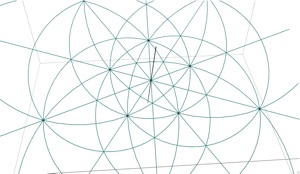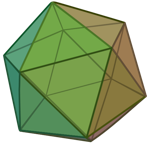
Icosahedron












Möbius transformations such as S, T coming from from the special unitary group (i.e., determinant 1 with inverse equal to the conjugate transpose) correspond to rotations of the unit sphere via stereographic projection: there is a bijection between points (x, y, z) on the sphere of radius 1 centered at the origin and points s in the complex plane along with a point at infinity coming from the south pole (0, 0, -1) given by
Viewing S, T as rotations, they generate the symmetry group of the Platonic solid with twenty faces known as the icosahedron. In this way, the function r(τ) is modular up to the symmetry of the figure
We used Geogebra 3D to visualize the stereographic projection of the icosahedron to the complex plane: We first inscribed the figure in a unit sphere. Then we tessellated the sphere by drawing great circles through every pair of neighboring vertices. Finally, we projected the tessellation from the south pole as above.

